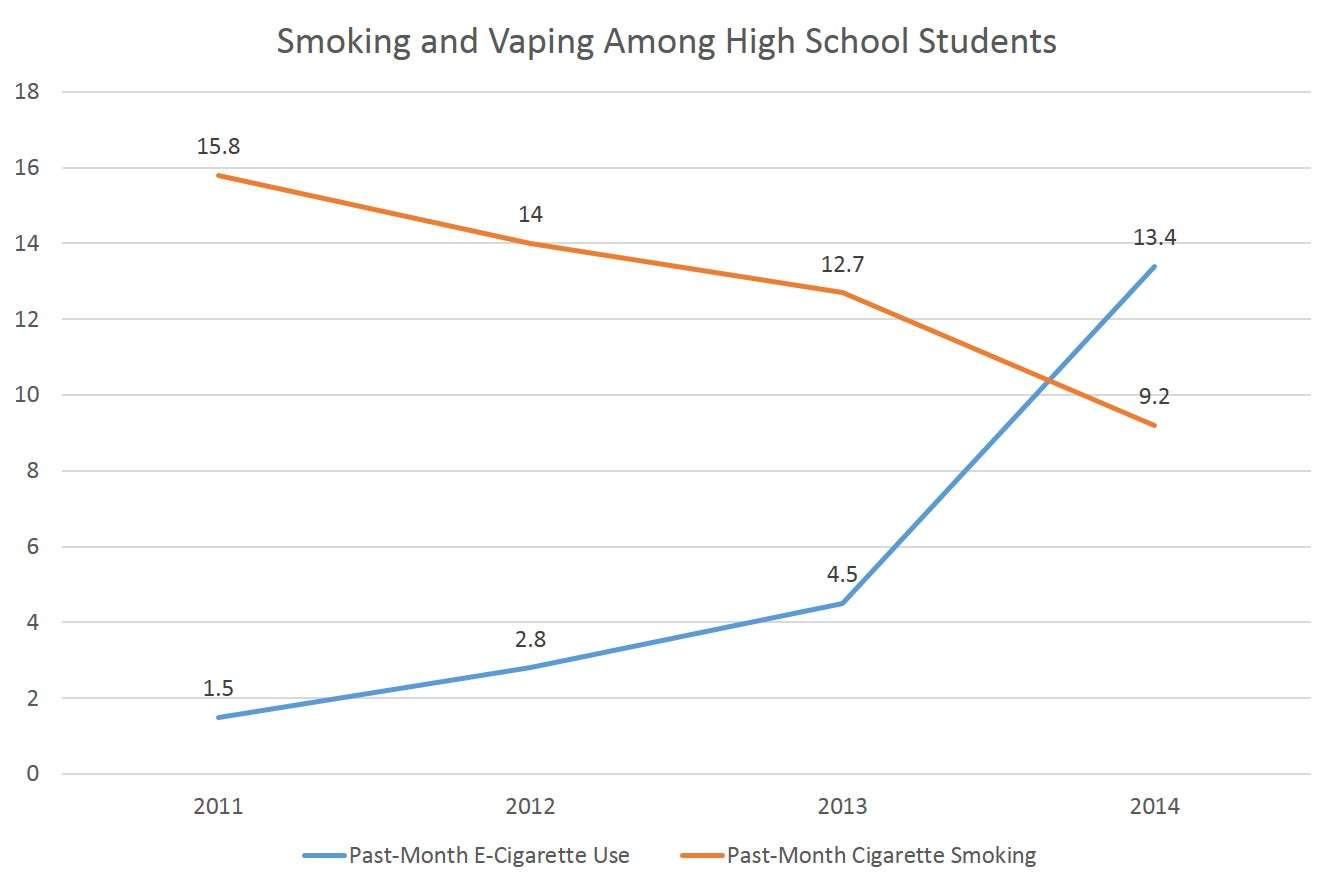E-Cigarettes Are Not Tobacco Products
The CDC misleads the public about the hazards of vaping.

For years anti-smoking activists and public health officials have tried to justify their irrational hatred of electronic cigarettes by arguing that vaping leads to smoking, especially among impressionable young people who otherwise would never touch tobacco. But that is not happening. To the contrary, vaping and smoking rates among teenagers are moving in opposite directions. Rather than admit they were wrong to claim that e-cigarettes are a "gateway" to the conventional kind, opponents of vaping have escalated their prevarications by implying, in defiance of all scientific evidence, that there is no important difference between the two kinds of nicotine delivery devices.
According to the latest numbers from the National Youth Tobacco Survey, which the U.S. Centers for Disease Control and Prevention (CDC) released the week before last, 13.4 percent of high school students reported past-month use of e-cigarettes in 2014, up from 4.5 percent in 2013. During the same period, the rate of past-month e-cigarette use among middle school students rose from 1.1 percent to 3.9 percent. "E-Cigarette Use Triples Among Middle and High School Students in Just One Year," said the headline over the CDC's press release, which spawned myriad news reports highlighting that point.
Less noticed was a fact relegated to the fourth paragraph: "Cigarette use declined among high school students and remained unchanged for middle school students." Among high school students, 9.2 percent reported past-month cigarette use in 2014, down from 12.7 percent in 2013. Among middle school students, 2.5 percent reported past-month cigarette use, down from 2.9 percent in 2013. The latter drop was not statistically significant, which is why the CDC says the rate "remained unchanged."
The divergence between vaping and smoking is even more dramatic when you look at the period from 2011 through 2014, when the rate of past-month e-cigarette use rose from 1.5 percent to 13.4 percent among high school students and from 0.6 percent to 3.9 percent among middle school students. Meanwhile, past-month cigarette smoking fell from 15.8 percent to 9.2 percent in the older group and from 4.3 percent to 2.5 percent in the younger group. Needless to say, this is not what you would expect to see if vaping encouraged smoking.
If anything, these data suggest that e-cigarettes are replacing the real thing. As one tobacco researcher told The New York Times, "They're not a gateway in, and they might be accelerating the gateway out." That cannot be anything but good news from a public health perspective, given the huge difference in risk between vaping and smoking.

The CDC refuses to see it that way. "This is a really bad thing," CDC Director Tom Frieden told the Times. "This is another generation being hooked by the tobacco industry. It makes me angry."
Wait a minute. "The tobacco industry" is hooking kids on e-cigarettes? Although tobacco companies have begun to enter the e-cigarette business in recent years, the two industries are hardly synonymous. Leaving aside the question of ownership, e-cigarettes do not burn and contain no tobacco, which is why they are so much safer than traditional cigarettes. It is more than a little misleading to classify them as tobacco products.
Yet that is what the CDC does. When it claims "there was no decline in overall tobacco use between 2011 and 2014," it is counting e-cigarettes as tobacco products. That makes as much sense as counting nicotine gum or patches (which also contain nicotine derived from tobacco) as tobacco products. This is no mere word game, because it is not true that "there was no decline in overall tobacco use between 2011 and 2014." The CDC is lying to us.
Similarly, the American Lung Association suggests that the decline in smoking is "offset by the dramatic increase in use of e-cigarettes," which is scientifically absurd given the clear health advantages of vaping. This is not simply a matter of emphasis or opinion. In terms of health effects, it cannot possibly be true that the increase in e-cigarette use offsets the decline in smoking.
A recent article in New Scientist illustrates the extent to which critics of e-cigarettes are misleading the public:
[Brian] King [an epidemiologist with the CDC's Office on Smoking and Health] says the CDC rejects any notion that replacing cigarettes with e-cigarettes is positive, and claims that e-cigarettes are actually prompting youngsters to take up smoking, not just taking the place of cigarettes. "In just one year, the number of kids using hookah doubled, and the number of kids using e-cigarettes appears to have tripled," he says. "These increases are driving an uptick in the total number of our children who are using tobacco products for the first time in a generation."
Again, this is true only if you insist on calling e-cigarettes tobacco products, which they aren't. Michael Siegel, a Boston University public health professor who used to work at the CDC, wonders, "How can the CDC possibly claim that a youth smoker switching completely to e-cigarette use is not a good thing?"
Contrary to the impression left by the CDC, regular vaping, as opposed to experimentation, seems to be much more common among smokers trying to quit or cut back than it is among people who have never tried tobacco. That is true of teenagers as well as adults.
A study published last week in BMJ Open, based on surveys of students in Wales, found that only 1.5 percent of 11-to-16-year-olds reported using e-cigarettes at least once a month, and almost all of those monthly vapers were also smokers. "Many young people (including never-smokers) have tried e-cigarettes," the researchers write. "However, regular use is less common, and is associated with tobacco cigarette use." They conclude that "e-cigarettes are unlikely to make a major direct contribution to adolescent nicotine addiction."
Michael Siegel notes similar findings in other surveys of British teenagers. "Among nonsmoking youth," he writes, "all use of e-cigarettes was mere experimentation. There was zero (0) regular use of e-cigarettes (defined as using e-cigarettes more than once per week)….The only regular use of e-cigarettes was observed among current and former smokers."
As Siegel points out, the CDC's National Youth Tobacco Survey does not ask teenagers how often they use e-cigarettes, just whether they have used them in the previous month or the previous year. Hence the survey cannot tell us how many recent users are regular users rather than experimenters. Siegel argues that the CDC "is misleading the public not only through its outright lies, dishonesty, and deception about e-cigarettes, but also by its failure to ask the right questions to actually test its pre-determined conclusions."
This article originally appeared at Forbes.com.
Thumbnail image credit: www.vaping360.com


Show Comments (58)